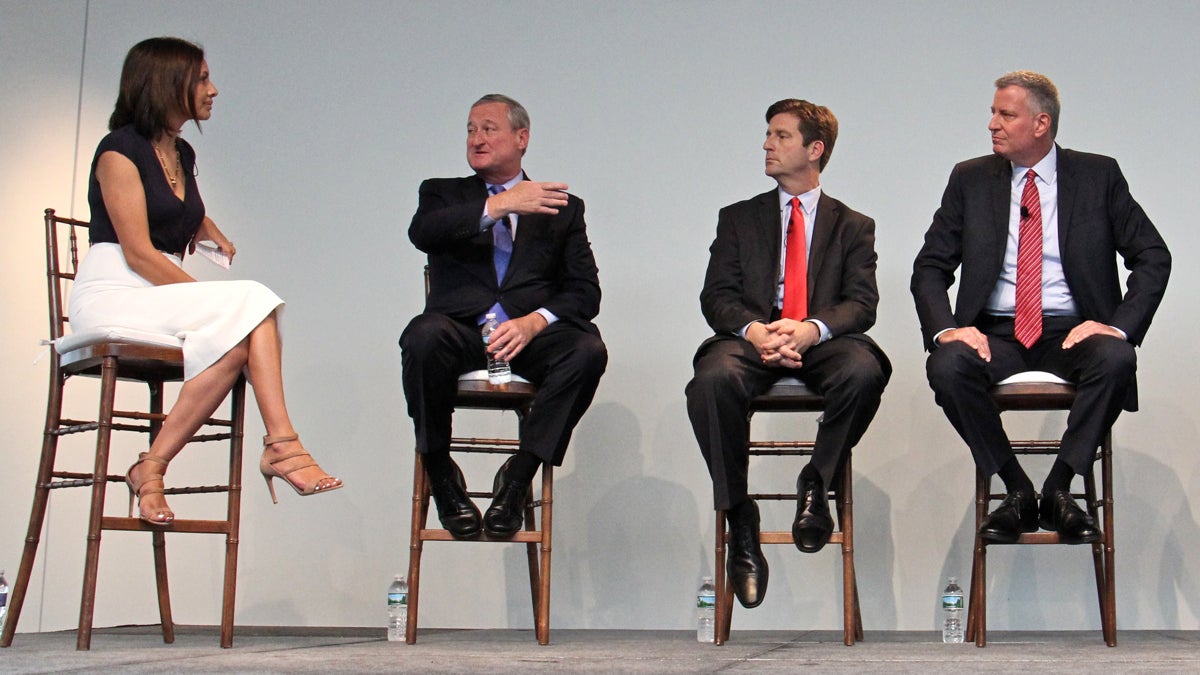Cities and immigrants: Three views
Listen
President of Voto Latino Maria Teresa Kumar (left) moderates a discussion on immigration and federal policy with (from left) Philadelphia Mayor Jim Kenney
Three mayors talk about how their cities treat undocumented immigrants.
When mayors sit and talk, especially if their cities have a sizable immigrant population, they tend to think in practical terms . That’s what three mayors focused on at a forum this week on how immigration issues play locally.
For the mayors of Philadelphia , New York and Phoenix the positive economic and social impact of immigrants is a no-brainer. The problem is often finding ways to stimulate old and new immigrants to participate in the political and social life of their cities. And for the general population, says New York City mayor Bill de Blasio, to leave their prejudices behind and remember their own pasts.
“Anyone who thinks that they don’t have an American story that one point involved discrimination, in the sense of coming from the wrong place, doesn’t know American history,” de Blasio said.
Both de Blasio and Philadelphia Mayor Jim Kenney recalled the stories of hardship in their own families, immigrants from Italy and Ireland, respectively.
They recognize that active involvement in the social fabric of a modern city is not a given, when undocumented immigrants live in fear of being caught and perhaps deported. There’s another important part to the equation, said Kenney,
“If these were white European undocumented immigrants we wouldn’t be having this discussion. This is about brown people. What we deal with a lot of problems in our world and our country are race-based,” he said.
To tackle some of these issues, Kenney wants more diversity in every city institution and service in Philadelphia.
“There’s no or little connection from the ethnic communities to their governments,” he said. “Immigrants rarely have someone to relate to when they go to get licenses for businesses or other paperwork, and I think if we can bring more diversity in every department in our city we can be really welcoming to people because they’re part of our community.”
Ten percent of Philadelphia’s population is made up of immigrants, and according to Kenney 27 percent of businesses are headed by immigrants.
De Blasio has just launched ID-NYC, a card that allows any resident to be have an ID card regardless of their status.
“For a lot of people, it’s the only ID they could get to visit a child’s school or get into a hospital to visit a loved one or get a lease, get a bank account.” It’s very popular not only with undocumented immigrants, de Blasio said, but also with the NYPD.
Los Angeles and San Francisco have already issued similar municipal ID cards. Other cities including Reading, Pennsylvania, have toyed with the idea.
The goal is to get immigrants to feel they’re part of the cities they populate. That sense of belonging is also a basic economic development tool for Phoenix Mayor Greg Stanton. He governs a city with a near majority Latino population that is, he says, “young, bilingual and entrepreneurial, exactly what you need for a city to thrive economically.”
All that in contrast to a state with laws that are not always welcoming to immigrants.
Stanton wants to strengthen the trade ties with Mexico, Central and South America and has opened an office in Mexico City.
It remains to be seen what role immigration reform will play in the upcoming elections.
The forum, called “Strength of the Union, The Power of 240 Years of Immigration in the United States” was sponsored by the City of Philadelphia, and was held at the National Museum of American Jewish History.
WHYY is your source for fact-based, in-depth journalism and information. As a nonprofit organization, we rely on financial support from readers like you. Please give today.

